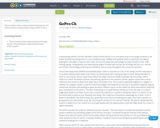
Teach students better swing mechanics through the use of biomechanics swing analysis using a GoPro camera.
- Subject:
- Physical Science
- Material Type:
- Lesson
- Date Added:
- 09/20/2018

Teach students better swing mechanics through the use of biomechanics swing analysis using a GoPro camera.

This resource is a video abstract of a research paper created by Research Square on behalf of its authors. It provides a synopsis that's easy to understand, and can be used to introduce the topics it covers to students, researchers, and the general public. The video's transcript is also provided in full, with a portion provided below for preview:
"Early-onset knee osteoarthritis is commonly observed after ACL reconstruction, and may be attributable to residual abnormal joint mechanics following surgery. Graft tunnel placement is a surgical factor that may affect internal knee joint mechanics, and thereby joint health. In this study, researchers from the University of Wisconsin used a combination of MRI and computational modeling to assess the consequences of graft placement on the loading of cartilage in the knee. The findings, reported in the _American Journal of Sports Medicine_, highlight the aspects of graft placement that surgeons should most closely consider to restore normal mechanics during ACL reconstruction. MRI measurements were performed to assess the ACL tunnel location and graft angle in the knees of 18 participants who had undergone ACL reconstruction. A clinical laxity test was performed on each subject following the completion of post-surgery physical therapy..."
The rest of the transcript, along with a link to the research itself, is available on the resource itself.

This resource is a video abstract of a research paper created by Research Square on behalf of its authors. It provides a synopsis that's easy to understand, and can be used to introduce the topics it covers to students, researchers, and the general public. The video's transcript is also provided in full, with a portion provided below for preview:
"One of the goals of ACL reconstruction surgery is to eliminate anterolateral rotational laxity of the knee. Biomechanical studies have shown that rotational control of the knee is largely controlled by the iliotibial band—specifically, the Kaplan fibers that anchor the band to the distal femur. Despite this critical connection, it remains unclear how often the iliotibial band and Kaplan fibers are compromised in association with ACL injury. To find out, researchers examined data for 267 patients with ACL-injured knees undergoing reconstruction surgery. They analyzed MRI scans to determine the extent of Kaplan fiber injury, and correlated those findings with the grade of pivot shift reported by the surgeon before the procedure. Only 47 patients, or approximately 18% of all patients, showed a Kaplan fiber injury. The majority of patients in the intact and injured Kaplan fiber groups had a grade-2 pivot shift. While only about 5% of all patients had a grade-3 pivot shift..."
The rest of the transcript, along with a link to the research itself, is available on the resource itself.

This is a basic introduction to Kinovea set up as assignments that may be used for any number of educational platforms. The user may transport this material into blackboard, canvas or alter them for print assignments to use for a hands-on lab component. This component may be used in conjunction with: The Applied Critical Thinking in Biomechanics Laboratory Manual All authors: Dr. Jennifer J. Brown1, Dr. Resa Chandler2, Dr. Vanessa Fiaud3, and Dr. Cortney Armitano-Lago4Elizabeth City State University1, Western Carolina University2, West Texas A&M University3, and UNC School of Medicine, Thurston Arthritis Research Center4
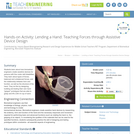
Students learn about how biomedical engineers create assistive devices for persons with fine motor skill disabilities. They learn about types of forces, balanced and unbalanced forces, and the relationship between form and function, as well as the structure of the hand. They do this by designing, building and testing their own hand "gripper" prototypes that are able to grasp and lift a 200 ml cup of sand.

This resource is a video abstract of a research paper created by Research Square on behalf of its authors. It provides a synopsis that's easy to understand, and can be used to introduce the topics it covers to students, researchers, and the general public. The video's transcript is also provided in full, with a portion provided below for preview:
"Glioblastoma (GBM), an aggressive cancer in the brain or spinal cord, is a devastating diagnosis. Although therapies exist, GBM has a poor prognosis, with a median survival of only 14-15 months after diagnosis. Key to its aggressiveness is the degree to which migrating GBM cells infiltrate adjacent brain tissue. GBM cells express the protein MACC1, which is a marker of metastasis and tumor cell migration. Unfortunately, how GBM cells learn to migrate is unclear. A recent study used live-cell and atomic force microscopy to evaluate cell migration and mechanical properties of GBM cells overexpressing MACC1. The results showed that MACC1 increased the migratory speed and elasticity of GBM cells while it decreased cell-cell adhesion and inhibited aggregation. MACC1-overexpressing cells also had specific increases in protrusive actin, allowing the cells to adhere to laminin..."
The rest of the transcript, along with a link to the research itself, is available on the resource itself.
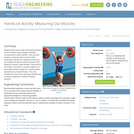
Student teams build model hand dynamometers used to measure grip strengths of people recovering from sports injuries. They use their models to measure how much force their classmates muscles are capable of producing, and analyze the data to determine factors that influence a person's grip strength. They use this information to produce a recommendation of a hand dynamometer design for a medical office specializing in physical therapy. They also consider the many other ways grip strength data is used by engineers to design everyday products.

This course provides an introduction to the mechanics of solids with applications to science and engineering. We emphasize the three essential features of all mechanics analyses, namely: (a) the geometry of the motion and/or deformation of the structure, and conditions of geometric fit, (b) the forces on and within structures and assemblages; and (c) the physical aspects of the structural system (including material properties) which quantify relations between the forces and motions/deformation.

Modelling is about understanding the nature: our world, ourselves and our work. Everything that we observe has a cause (typically several) and has the effect thereof. The heart of modelling lies in identifying, understanding and quantifying these cause-and-effect relationships.
A model can be treated as a (selective) representation of a system. We create the model by defining a mapping from the system space to the model space, thus we can map system state and behaviour to model state and behaviour. By defining the inverse mapping, we may map results from the study of the model back to the system. In this course, using an overarching modelling paradigm, students will become familiar with several instances of modelling, e.g., mechanics, thermal dynamics, fluid mechanics, etc.

This course develops and applies scaling laws and the methods of continuum and statistical mechanics to biomechanical phenomena over a range of length scales, from molecular to cellular to tissue or organ level.
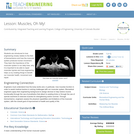
Students are introduced to the field of biomechanics and how the muscular system produces human movement. They learn the importance of the muscular system in our daily lives, why it is important to be able to repair muscular system injuries and how engineering can help.

This course covers the growth, development and structure of normal bone and joints, the biomechanics of bone connective tissues, and their response to stress, calcium and phosphate homeostasis. Additional topics include regulation by parathyroid hormone and vitamin D, the pathogenesis of metabolic bone diseases and diseases of connective tissues, joints and muscle with consideration of possible mechanisms and underlying metabolic derangements.
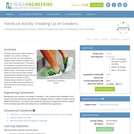
Students explore why different types of sneakers are used in a variety of common sports, and how engineers analyze design needs in sneakers and many other everyday items. The goal is for students to understand the basics of engineering associated with the design of athletic shoes. The design of footware based on how it will be used involves bioengineering. Students analyze the foot movements in a variety of sports, develop design criteria for a specific sport, and make recommendations for requirements for the sneakers used in that sport.
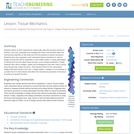
Students reflect on their experiences making silly putty (the previous hands-on activity in the unit), especially why changing the borax concentration alters the mechanical properties of silly putty and how this pertains to tissue mechanics. Students learn why engineers must understand tissue mechanics in order to design devices that will be implanted or used inside bodies, to study pathologies of tissues and how this alters tissue function, and to design prosthetics. Finally, students learn about collagen, elastin and proteoglycans and their roles in giving body tissues their unique functions. This prepares them for the culminating design-build-test activity of the unit.

This resource is a video abstract of a research paper created by Research Square on behalf of its authors. It provides a synopsis that's easy to understand, and can be used to introduce the topics it covers to students, researchers, and the general public. The video's transcript is also provided in full, with a portion provided below for preview:
"Recent studies have shown that all-inside repair of meniscal ramp lesions can restore normal knee motion. But it has remained unclear how ramp lesion repairs affect ACL in situ forces and bony contact forces. To remedy that, researchers from the University of Pittsburgh recently used a robotic system to examine these forces in intact knees, knees with ramp lesions, and knees with ramp lesion repairs. Their findings, reported in the November issue of the American Journal of Sports Medicine, suggest that the indications for ramp lesion repair may be limited. The team looked at nine knees from human cadavers, each tested using a six-degree-of-freedom robotic system. The knees were continuously flexed from full extension to 90° under five different loads: an anterior load, an external-rotation torque, a combined anterior and compression load, and a combination of external- or internal-rotation torque and compression..."
The rest of the transcript, along with a link to the research itself, is available on the resource itself.